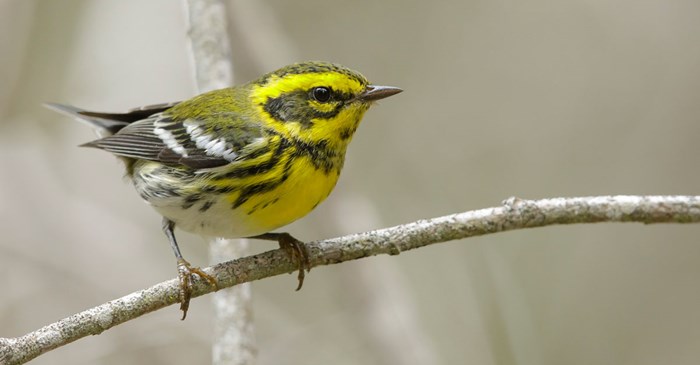Townsend’s Warbler is a handsome yellow bird with dramatic black markings, deserving of any birder’s must-see list. If you plan to spend any time along the Pacific Coast in the winter, it’s an opportune time to get an up-close look at this beauty.
Where can you find Townsend’s Warbler?
This little bird migrates from the Pacific Northwest to winter in Mexico and Central America, as well as the Pacific coastline of the U.S. As it turns out, winter is a fitting time to look for this bird, because unlike the summer months, they do more of their foraging at eye level, searching in shorter trees as well as shrubs. By summer, they’re trickier to find, as their preferred nesting area and food sources are high in the treetops of the conifers.
Like many warblers, they’re not famous for their ability to belt out a memorable forest melody. Rather, their song sounds more like a raspy series of urgent whistles — weazy weazy weazy tweea! — demanding their rivals to back off and be gone.
In late winter, males may start giving voice to what lies ahead, springtime, migration, and nesting. Before and during migration, male Townsend’s Warblers will occasionally sing their courtship song. When they’re back in their old-growth forests, you’ll hear their buzzy songs ringing through the treetops of the old-growth pine forests, as males establish territories and battle with other males over boundary disputes.
What do Townsends’ Warblers eat?
Up in the treetops during the summer, Townsend’s Warblers grab insects and larvae from the pine needles and bark, but will sometimes catch insects from midair. During the off-months of insect season, Townsend’s Warblers have developed resourceful, ingenious foraging methods. During migration, they’ve been observed eating flower nectar. During winter, some thrive on the secretions (“honeydew”) of scale insects that live off tree sap.
These little birds rarely visit feeders. However, during the winter months on the Pacific coast, they’ve been known to fly in for a look. If they’re in your neighborhood, try stocking your feeder with Lyric Fine Tunes No Waste Mix. With the array of finely cut nuts and seeds, you can give them access to a food source their beaks can accommodate.
